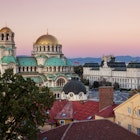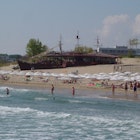
May 1, 2025 • 11 min read
Whether you fancy a day walk through stunning alpine landscapes or a multi-day hike linking remote mountain villages, Bulgaria delivers hikes to remember.

May 1, 2025 • 11 min read
Whether you fancy a day walk through stunning alpine landscapes or a multi-day hike linking remote mountain villages, Bulgaria delivers hikes to remember.

Mar 24, 2025 • 7 min read
Heading to Bulgaria? Get ready for plenty of outdoor action! Here are the best times to come for the beaches, hiking, skiing and colorful festivals.

Mar 9, 2025 • 7 min read
Explore the diverse culture and incredible landscapes of Bulgaria at these top places to visit.

Aug 1, 2024 • 6 min read
There’s much more to this charming mountain town than skiing and snowboarding. Here’s what you can enjoy in all seasons.

Jul 18, 2024 • 5 min read
Welcome to the sun-soaked coast of Bulgaria! Here are the region's best beaches.

Oct 20, 2023 • 7 min read
This 460-mile ride along the Danube through Bulgaria is one of Europe’s least known long-distance routes. Here’s how to tackle it.

Feb 1, 2021 • 5 min read
Explore the Balkan Peninsula and the turquoise waters of the Adriatic with these scenic drives in southeastern Europe – a perfect road trip experience.

Feb 20, 2020 • 3 min read
From hiking to wildlife watching, Bulgaria's Rila National Park uses sustainable initiatives that active eco travellers will love.

Jan 30, 2020 • 4 min read
Until recently Plovdiv was almost unknown outside of Bulgaria, but now, Europe’s oldest city is finally trending. Here's how to spend a perfect weekend there.

Dec 4, 2019 • 5 min read
Hike in Bulgaria to witness astonishing geological variety: blue-hued caves, 3000m peaks and sandstone pyramids straight out of a Salvador Dalí painting.

Dec 4, 2019 • 3 min read
Beautiful Bulgaria is bulging with adventure, be it beavering through bountiful mountains or diving below the blue waters of the Black Sea.

Oct 13, 2019 • 4 min read
A vibrant arts scene, heartwarming food, fascinating history and a chilled-out vibe - here's Lonely Planet's guide to the best things to do in Sofia.

Feb 19, 2019 • 5 min read
Bulgaria’s capital usually brings to mind associations with hearty Balkan cuisine that is best washed down with an invigorating glass of rakia (local…

Jun 1, 2018 • 4 min read
After enjoying Sofia’s eclectic cultural scene, laid-back atmosphere and many restaurants and clubs, many travellers head straight to Bulgaria’s Black Sea…

Apr 25, 2018 • 5 min read
Lonely Planet Local Yoana Hristova has had her share of roaming around the world, but she has returned to her home in Sofia only to fall in love with the…

Oct 14, 2016 • 5 min read
Time-travel from medieval battles to chic cocktail bars in one of Bulgaria’s oldest cities. As the country’s former capital, Veliko Târnovo has history…

Jun 8, 2016 • 4 min read
One of Europe’s youngest capitals, Sofia also happens to be among its oldest settlements, stretching back several millennia from ancient Thracian and…

Dec 15, 2014 • 4 min read
Skimpy swimwear: check. Sunblock, good book, readiness to swill umbrella-spiked cocktails: check. Ridiculous sums of money to enjoy a spectacular European…

Oct 14, 2014 • 3 min read
One of the Balkans' larger countries, Bulgaria makes an excellent place for road tripping. Despite now being an EU member, enough of Bulgaria’s wildness …